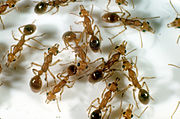Wikipedia:Today's featured article/December 15, 2018
Nothomyrmecia, the dinosaur ant, has the most primitive body structure among all living ants. First described by the entomologist John S. Clark in 1934, the genus's rediscovery in Poochera, South Australia, in 1977 attracted scientists from around the world. It nests in old-growth mallee and Eucalyptus woodlands. A medium-sized ant, Nothomyrmecia macrops measures 9.7–11 mm (0.38–0.43 in). Mature colonies are very small, with only 50 to 100 individuals. Workers are nocturnal, solitary foragers, collecting arthropod prey and sweet substances such as honeydew. The ants rely on their vision to navigate; there is no evidence that they use chemicals to help them forage. The queen produces just one generation of ants each year, and initially joins the workers in foraging. Colder temperatures aid the ants by inhibiting their competitors and predators, and climate change poses a threat. The International Union for Conservation of Nature lists the genus as critically endangered. (Full article...)
